单点登录(SSO),一看就会,一做就错!
技术这东西吧,看别人写的好像很简单似的,到自己去写的时候就各种问题,“一看就会,一做就错”。

图片来自 Pexels
网上关于实现 SSO 的文章一大堆,但是当你真的照着写的时候就会发现根本不是那么回事儿,简直让人抓狂,尤其是对于我这样的菜鸟。
几经曲折,终于搞定了,决定记录下来,以便后续查看。先来看一下效果:
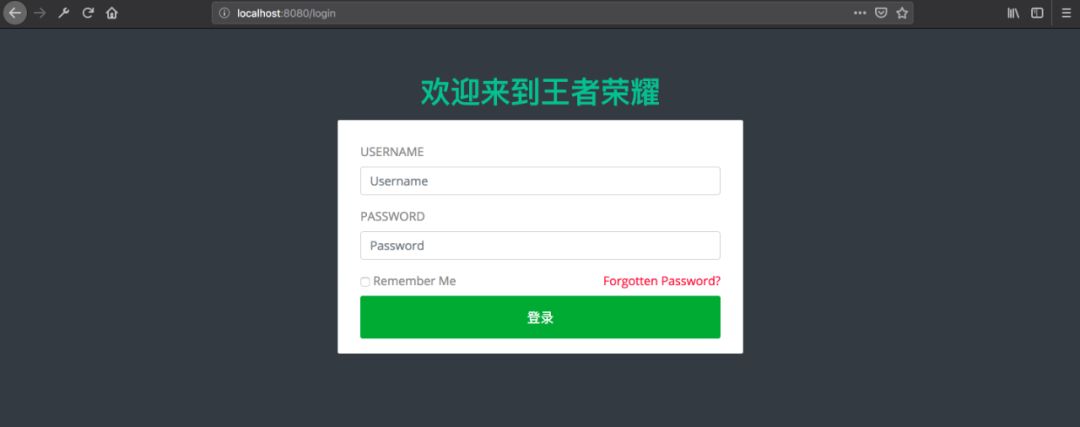
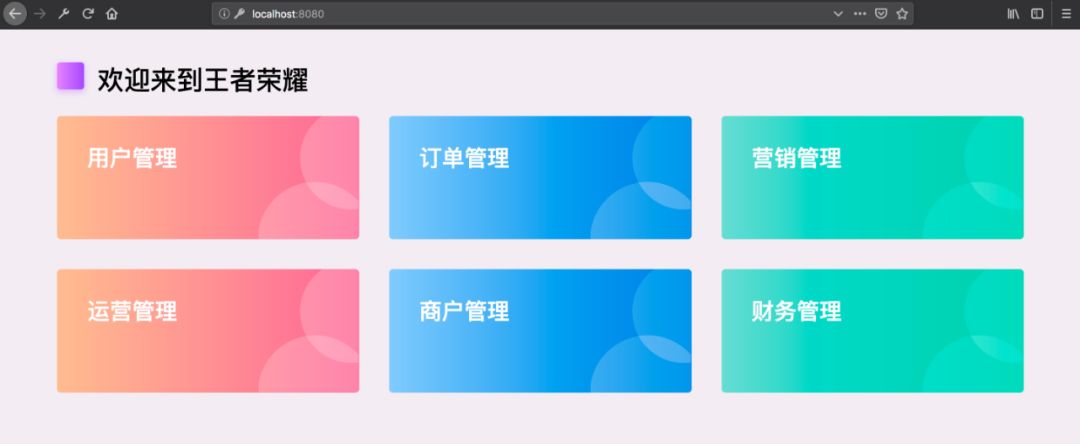

准备
①单点登录

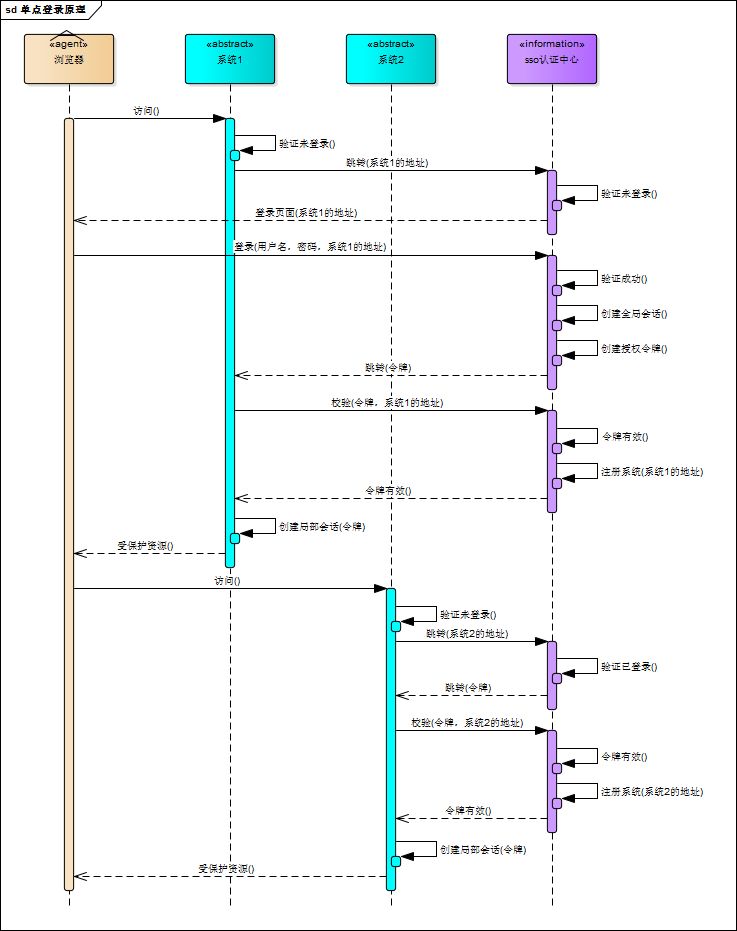
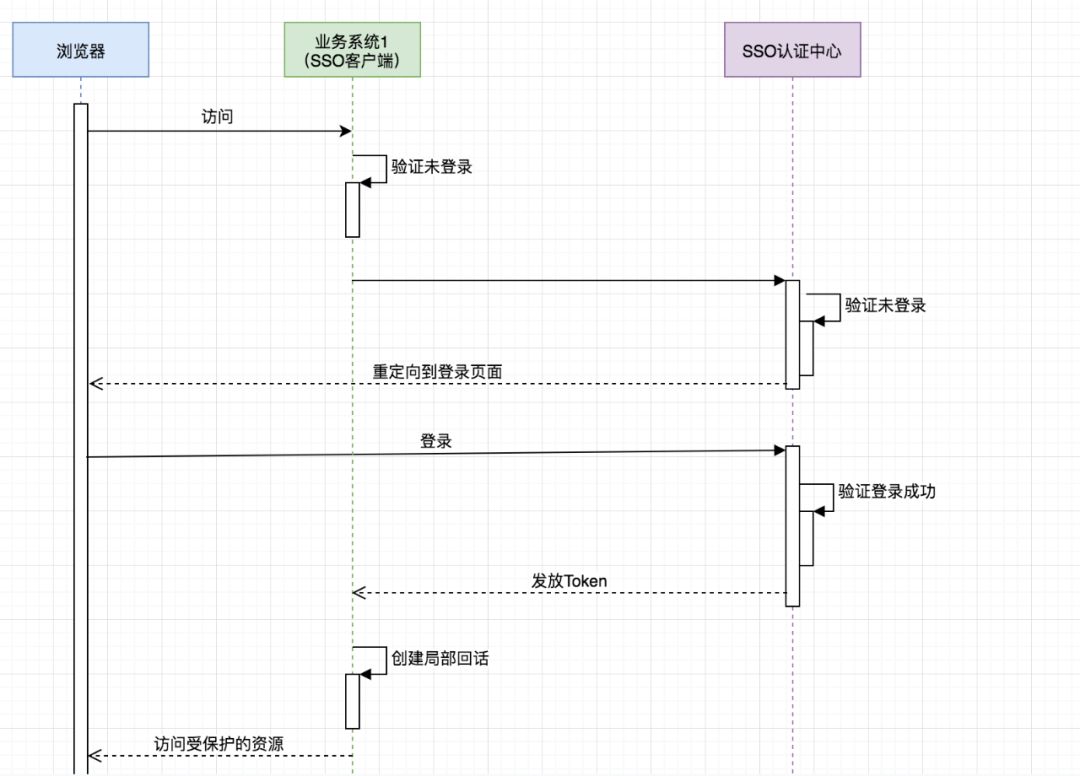
重要的是理解:
SSO 服务端和 SSO 客户端直接是通过授权以后发放 Token 的形式来访问受保护的资源。
相对于浏览器来说,业务系统是服务端,相对于 SSO 服务端来说,业务系统是客户端。
浏览器和业务系统之间通过会话正常访问。
不是每次浏览器请求都要去 SSO 服务端去验证,只要浏览器和它所访问的服务端的会话有效它就可以正常访问。
利用 OAuth2 实现单点登录
认证服务器配置
<?xml version="1.0" encoding="UTF-8"?>
<project xmlns="http://maven.apache.org/POM/4.0.0" xmlns:xsi="http://www.w3.org/2001/XMLSchema-instance"
xsi:schemaLocation="http://maven.apache.org/POM/4.0.0 http://maven.apache.org/xsd/maven-4.0.0.xsd">
<modelVersion>4.0.0</modelVersion>
<parent>
<groupId>org.springframework.boot</groupId>
<artifactId>spring-boot-starter-parent</artifactId>
<version>2.1.3.RELEASE</version>
<relativePath/> <!-- lookup parent from repository -->
</parent>
<groupId>com.cjs.sso</groupId>
<artifactId>oauth2-sso-auth-server</artifactId>
<version>0.0.1-SNAPSHOT</version>
<name>oauth2-sso-auth-server</name>
<properties>
<java.version>1.8</java.version>
</properties>
<dependencies>
<dependency>
<groupId>org.springframework.boot</groupId>
<artifactId>spring-boot-starter-data-jpa</artifactId>
</dependency>
<dependency>
<groupId>org.springframework.boot</groupId>
<artifactId>spring-boot-starter-data-redis</artifactId>
</dependency>
<dependency>
<groupId>org.springframework.boot</groupId>
<artifactId>spring-boot-starter-security</artifactId>
</dependency>
<dependency>
<groupId>org.springframework.security.oauth.boot</groupId>
<artifactId>spring-security-oauth2-autoconfigure</artifactId>
<version>2.1.3.RELEASE</version>
</dependency>
<dependency>
<groupId>org.springframework.boot</groupId>
<artifactId>spring-boot-starter-thymeleaf</artifactId>
</dependency>
<dependency>
<groupId>org.springframework.boot</groupId>
<artifactId>spring-boot-starter-web</artifactId>
</dependency>
<dependency>
<groupId>org.springframework.session</groupId>
<artifactId>spring-session-data-redis</artifactId>
</dependency>
<dependency>
<groupId>mysql</groupId>
<artifactId>mysql-connector-java</artifactId>
<scope>runtime</scope>
</dependency>
<dependency>
<groupId>org.projectlombok</groupId>
<artifactId>lombok</artifactId>
<optional>true</optional>
</dependency>
<dependency>
<groupId>org.springframework.boot</groupId>
<artifactId>spring-boot-starter-test</artifactId>
<scope>test</scope>
</dependency>
<dependency>
<groupId>org.springframework.security</groupId>
<artifactId>spring-security-test</artifactId>
<scope>test</scope>
</dependency>
<dependency>
<groupId>org.apache.commons</groupId>
<artifactId>commons-lang3</artifactId>
<version>3.8.1</version>
</dependency>
<dependency>
<groupId>com.alibaba</groupId>
<artifactId>fastjson</artifactId>
<version>1.2.56</version>
</dependency>
</dependencies>
<build>
<plugins>
<plugin>
<groupId>org.springframework.boot</groupId>
<artifactId>spring-boot-maven-plugin</artifactId>
</plugin>
</plugins>
</build>
</project>
spring:
datasource:
url: jdbc:mysql://localhost:3306/permission
username: root
password: 123456
driver-class-name: com.mysql.jdbc.Driver
jpa:
show-sql: true
session:
store-type: redis
redis:
host: 127.0.0.1
password: 123456
port: 6379
server:
port: 8080
package com.cjs.sso.config;
import org.springframework.beans.factory.annotation.Autowired;
import org.springframework.context.annotation.Bean;
import org.springframework.context.annotation.Configuration;
import org.springframework.context.annotation.Primary;
import org.springframework.security.core.token.DefaultToken;
import org.springframework.security.oauth2.config.annotation.configurers.ClientDetailsServiceConfigurer;
import org.springframework.security.oauth2.config.annotation.web.configuration.AuthorizationServerConfigurerAdapter;
import org.springframework.security.oauth2.config.annotation.web.configuration.EnableAuthorizationServer;
import org.springframework.security.oauth2.config.annotation.web.configurers.AuthorizationServerEndpointsConfigurer;
import org.springframework.security.oauth2.config.annotation.web.configurers.AuthorizationServerSecurityConfigurer;
import org.springframework.security.oauth2.provider.token.DefaultTokenServices;
import org.springframework.security.oauth2.provider.token.TokenStore;
import org.springframework.security.oauth2.provider.token.store.JwtAccessTokenConverter;
import org.springframework.security.oauth2.provider.token.store.JwtTokenStore;
import javax.sql.DataSource;
/**
* @author ChengJianSheng
* @date 2019-02-11
*/
@Configuration
@EnableAuthorizationServer
public class AuthorizationServerConfig extends AuthorizationServerConfigurerAdapter {
@Autowired
private DataSource dataSource;
@Override
public void configure(AuthorizationServerSecurityConfigurer security) throws Exception {
security.allowFormAuthenticationForClients();
security.tokenKeyAccess("isAuthenticated()");
}
@Override
public void configure(ClientDetailsServiceConfigurer clients) throws Exception {
clients.jdbc(dataSource);
}
@Override
public void configure(AuthorizationServerEndpointsConfigurer endpoints) throws Exception {
endpoints.accessTokenConverter(jwtAccessTokenConverter());
endpoints.tokenStore(jwtTokenStore());
// endpoints.tokenServices(defaultTokenServices());
}
/*@Primary
@Bean
public DefaultTokenServices defaultTokenServices() {
DefaultTokenServices defaultTokenServices = new DefaultTokenServices();
defaultTokenServices.setTokenStore(jwtTokenStore());
defaultTokenServices.setSupportRefreshToken(true);
return defaultTokenServices;
}*/
@Bean
public JwtTokenStore jwtTokenStore() {
return new JwtTokenStore(jwtAccessTokenConverter());
}
@Bean
public JwtAccessTokenConverter jwtAccessTokenConverter() {
JwtAccessTokenConverter jwtAccessTokenConverter = new JwtAccessTokenConverter();
jwtAccessTokenConverter.setSigningKey("cjs"); // Sets the JWT signing key
return jwtAccessTokenConverter;
}
}
别忘了 @EnableAuthorizationServer。
Token 存储采用的是 JWT。
客户端以及登录用户这些配置存储在数据库,为了减少数据库的查询次数,可以从数据库读出来以后再放到内存中。
package com.cjs.sso.config;
import com.cjs.sso.service.MyUserDetailsService;
import org.springframework.beans.factory.annotation.Autowired;
import org.springframework.context.annotation.Bean;
import org.springframework.context.annotation.Configuration;
import org.springframework.security.config.annotation.authentication.builders.AuthenticationManagerBuilder;
import org.springframework.security.config.annotation.web.builders.HttpSecurity;
import org.springframework.security.config.annotation.web.builders.WebSecurity;
import org.springframework.security.config.annotation.web.configuration.EnableWebSecurity;
import org.springframework.security.config.annotation.web.configuration.WebSecurityConfigurerAdapter;
import org.springframework.security.crypto.bcrypt.BCryptPasswordEncoder;
import org.springframework.security.crypto.password.PasswordEncoder;
/**
* @author ChengJianSheng
* @date 2019-02-11
*/
@Configuration
@EnableWebSecurity
public class WebSecurityConfig extends WebSecurityConfigurerAdapter {
@Autowired
private MyUserDetailsService userDetailsService;
@Override
protected void configure(AuthenticationManagerBuilder auth) throws Exception {
auth.userDetailsService(userDetailsService).passwordEncoder(passwordEncoder());
}
@Override
public void configure(WebSecurity web) throws Exception {
web.ignoring().antMatchers("/assets/**", "/css/**", "/images/**");
}
@Override
protected void configure(HttpSecurity http) throws Exception {
http.formLogin()
.loginPage("/login")
.and()
.authorizeRequests()
.antMatchers("/login").permitAll()
.anyRequest()
.authenticated()
.and().csrf().disable().cors();
}
@Bean
public PasswordEncoder passwordEncoder() {
return new BCryptPasswordEncoder();
}
}
package com.cjs.sso.controller;
import org.springframework.stereotype.Controller;
import org.springframework.web.bind.annotation.GetMapping;
/**
* @author ChengJianSheng
* @date 2019-02-12
*/
@Controller
public class LoginController {
@GetMapping("/login")
public String login() {
return "login";
}
@GetMapping("/")
public String index() {
return "index";
}
}
<!DOCTYPE html>
<html xmlns:th="http://www.thymeleaf.org">
<head>
<meta charset="utf-8">
<meta http-equiv="X-UA-Compatible" content="IE=edge">
<title>Ela Admin - HTML5 Admin Template</title>
<meta name="description" content="Ela Admin - HTML5 Admin Template">
<meta name="viewport" content="width=device-width, initial-scale=1">
<link type="text/css" rel="stylesheet" th:href="@{/assets/css/normalize.css}">
<link type="text/css" rel="stylesheet" th:href="@{/assets/bootstrap-4.3.1-dist/css/bootstrap.min.css}">
<link type="text/css" rel="stylesheet" th:href="@{/assets/css/font-awesome.min.css}">
<link type="text/css" rel="stylesheet" th:href="@{/assets/css/style.css}">
</head>
<body class="bg-dark">
<div class="sufee-login d-flex align-content-center flex-wrap">
<div class="container">
<div class="login-content">
<div class="login-logo">
<h1 style="color: #57bf95;">欢迎来到王者荣耀</h1>
</div>
<div class="login-form">
<form th:action="@{/login}" method="post">
<div class="form-group">
<label>Username</label>
<input type="text" class="form-control" name="username" placeholder="Username">
</div>
<div class="form-group">
<label>Password</label>
<input type="password" class="form-control" name="password" placeholder="Password">
</div>
<div class="checkbox">
<label>
<input type="checkbox"> Remember Me
</label>
<label class="pull-right">
<a href="#">Forgotten Password?</a>
</label>
</div>
<button type="submit" class="btn btn-success btn-flat m-b-30 m-t-30" style="font-size: 18px;">登录</button>
</form>
</div>
</div>
</div>
</div>
<script type="text/javascript" th:src="@{/assets/js/jquery-2.1.4.min.js}"></script>
<script type="text/javascript" th:src="@{/assets/bootstrap-4.3.1-dist/js/bootstrap.min.js}"></script>
<script type="text/javascript" th:src="@{/assets/js/main.js}"></script>
</body>
</html>
定义客户端,如下图:

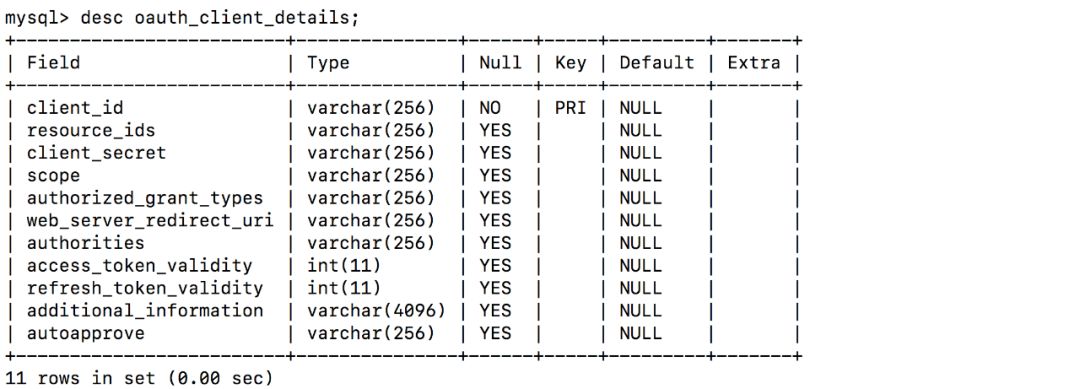
package com.cjs.sso.domain;
import lombok.Data;
import org.springframework.security.core.GrantedAuthority;
import org.springframework.security.core.userdetails.User;
import java.util.Collection;
/**
* 大部分时候直接用User即可不必扩展
* @author ChengJianSheng
* @date 2019-02-11
*/
@Data
public class MyUser extends User {
private Integer departmentId; // 举个例子,部门ID
private String mobile; // 举个例子,假设我们想增加一个字段,这里我们增加一个mobile表示手机号
public MyUser(String username, String password, Collection<? extends GrantedAuthority> authorities) {
super(username, password, authorities);
}
public MyUser(String username, String password, boolean enabled, boolean accountNonExpired, boolean credentialsNonExpired, boolean accountNonLocked, Collection<? extends GrantedAuthority> authorities) {
super(username, password, enabled, accountNonExpired, credentialsNonExpired, accountNonLocked, authorities);
}
}
package com.cjs.sso.service;
import com.alibaba.fastjson.JSON;
import com.cjs.sso.domain.MyUser;
import com.cjs.sso.entity.SysPermission;
import com.cjs.sso.entity.SysUser;
import lombok.extern.slf4j.Slf4j;
import org.springframework.beans.factory.annotation.Autowired;
import org.springframework.security.core.authority.SimpleGrantedAuthority;
import org.springframework.security.core.userdetails.UserDetails;
import org.springframework.security.core.userdetails.UserDetailsService;
import org.springframework.security.core.userdetails.UsernameNotFoundException;
import org.springframework.security.crypto.password.PasswordEncoder;
import org.springframework.stereotype.Service;
import org.springframework.util.CollectionUtils;
import java.util.ArrayList;
import java.util.List;
/**
* @author ChengJianSheng
* @date 2019-02-11
*/
@Slf4j
@Service
public class MyUserDetailsService implements UserDetailsService {
@Autowired
private PasswordEncoder passwordEncoder;
@Autowired
private UserService userService;
@Autowired
private PermissionService permissionService;
@Override
public UserDetails loadUserByUsername(String username) throws UsernameNotFoundException {
SysUser sysUser = userService.getByUsername(username);
if (null == sysUser) {
log.warn("用户{}不存在", username);
throw new UsernameNotFoundException(username);
}
List<SysPermission> permissionList = permissionService.findByUserId(sysUser.getId());
List<SimpleGrantedAuthority> authorityList = new ArrayList<>();
if (!CollectionUtils.isEmpty(permissionList)) {
for (SysPermission sysPermission : permissionList) {
authorityList.add(new SimpleGrantedAuthority(sysPermission.getCode()));
}
}
MyUser myUser = new MyUser(sysUser.getUsername(), passwordEncoder.encode(sysUser.getPassword()), authorityList);
log.info("登录成功!用户: {}", JSON.toJSONString(myUser));
return myUser;
}
}
验证:
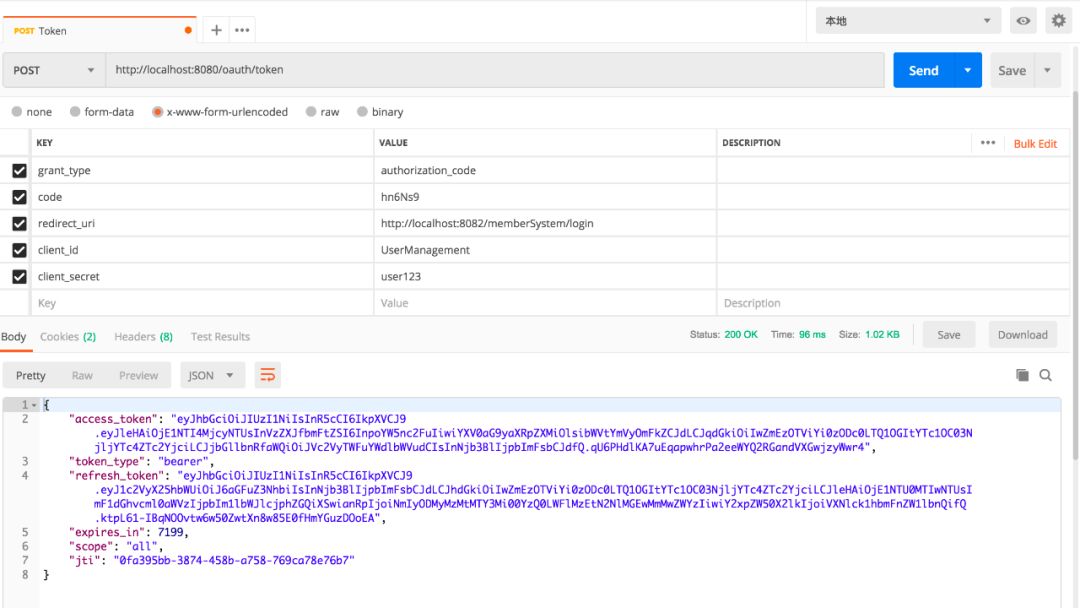
两个客户端
<?xml version="1.0" encoding="UTF-8"?>
<project xmlns="http://maven.apache.org/POM/4.0.0" xmlns:xsi="http://www.w3.org/2001/XMLSchema-instance"
xsi:schemaLocation="http://maven.apache.org/POM/4.0.0 http://maven.apache.org/xsd/maven-4.0.0.xsd">
<modelVersion>4.0.0</modelVersion>
<parent>
<groupId>org.springframework.boot</groupId>
<artifactId>spring-boot-starter-parent</artifactId>
<version>2.1.3.RELEASE</version>
<relativePath/> <!-- lookup parent from repository -->
</parent>
<groupId>com.cjs.sso</groupId>
<artifactId>oauth2-sso-client-member</artifactId>
<version>0.0.1-SNAPSHOT</version>
<name>oauth2-sso-client-member</name>
<description>Demo project for Spring Boot</description>
<properties>
<java.version>1.8</java.version>
</properties>
<dependencies>
<dependency>
<groupId>org.springframework.boot</groupId>
<artifactId>spring-boot-starter-data-jpa</artifactId>
</dependency>
<dependency>
<groupId>org.springframework.boot</groupId>
<artifactId>spring-boot-starter-oauth2-client</artifactId>
</dependency>
<dependency>
<groupId>org.springframework.boot</groupId>
<artifactId>spring-boot-starter-security</artifactId>
</dependency>
<dependency>
<groupId>org.springframework.security.oauth.boot</groupId>
<artifactId>spring-security-oauth2-autoconfigure</artifactId>
<version>2.1.3.RELEASE</version>
</dependency>
<dependency>
<groupId>org.springframework.boot</groupId>
<artifactId>spring-boot-starter-thymeleaf</artifactId>
</dependency>
<dependency>
<groupId>org.thymeleaf.extras</groupId>
<artifactId>thymeleaf-extras-springsecurity5</artifactId>
<version>3.0.4.RELEASE</version>
</dependency>
<dependency>
<groupId>org.springframework.boot</groupId>
<artifactId>spring-boot-starter-web</artifactId>
</dependency>
<dependency>
<groupId>com.h2database</groupId>
<artifactId>h2</artifactId>
<scope>runtime</scope>
</dependency>
<dependency>
<groupId>org.projectlombok</groupId>
<artifactId>lombok</artifactId>
<optional>true</optional>
</dependency>
<dependency>
<groupId>org.springframework.boot</groupId>
<artifactId>spring-boot-starter-test</artifactId>
<scope>test</scope>
</dependency>
<dependency>
<groupId>org.springframework.security</groupId>
<artifactId>spring-security-test</artifactId>
<scope>test</scope>
</dependency>
</dependencies>
<build>
<plugins>
<plugin>
<groupId>org.springframework.boot</groupId>
<artifactId>spring-boot-maven-plugin</artifactId>
</plugin>
</plugins>
</build>
</project>
application.yml:
server:
port: 8082
servlet:
context-path: /memberSystem
security:
oauth2:
client:
client-id: UserManagement
client-secret: user123
access-token-uri: http://localhost:8080/oauth/token
user-authorization-uri: http://localhost:8080/oauth/authorize
resource:
jwt:
key-uri: http://localhost:8080/oauth/token_key
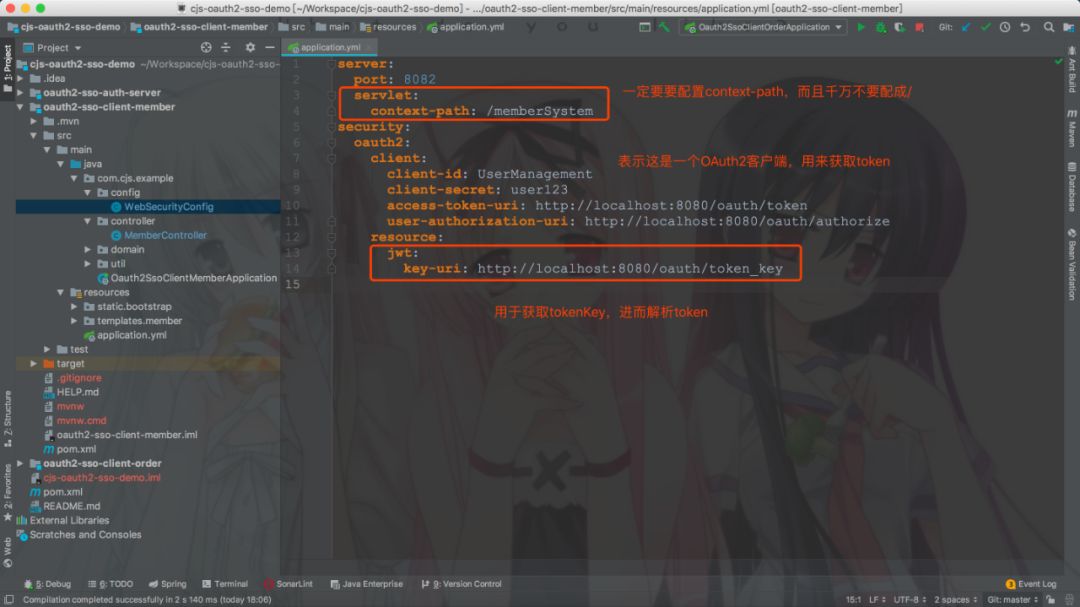
这里 context-path 不要设成 /,不然重定向获取 code 的时候回被拦截。
WebSecurityConfig:
package com.cjs.example.config;
import com.cjs.example.util.EnvironmentUtils;
import org.springframework.beans.factory.annotation.Autowired;
import org.springframework.boot.autoconfigure.security.oauth2.client.EnableOAuth2Sso;
import org.springframework.context.annotation.Configuration;
import org.springframework.security.config.annotation.web.builders.HttpSecurity;
import org.springframework.security.config.annotation.web.builders.WebSecurity;
import org.springframework.security.config.annotation.web.configuration.WebSecurityConfigurerAdapter;
/**
* @author ChengJianSheng
* @date 2019-03-03
*/
@EnableOAuth2Sso
@Configuration
public class WebSecurityConfig extends WebSecurityConfigurerAdapter {
@Autowired
private EnvironmentUtils environmentUtils;
@Override
public void configure(WebSecurity web) throws Exception {
web.ignoring().antMatchers("/bootstrap/**");
}
@Override
protected void configure(HttpSecurity http) throws Exception {
if ("local".equals(environmentUtils.getActiveProfile())) {
http.authorizeRequests().anyRequest().permitAll();
}else {
http.logout().logoutSuccessUrl("http://localhost:8080/logout")
.and()
.authorizeRequests()
.anyRequest().authenticated()
.and()
.csrf().disable();
}
}
}
说明:
最重要的注解是 @EnableOAuth2Sso。
权限控制这里采用 Spring Security 方法级别的访问控制,结合 Thymeleaf 可以很容易做权限控制。
顺便多提一句,如果是前后端分离的话,前端需求加载用户的权限,然后判断应该显示那些按钮那些菜单。
MemberController:
package com.cjs.example.controller;
import org.springframework.security.access.prepost.PreAuthorize;
import org.springframework.security.core.Authentication;
import org.springframework.stereotype.Controller;
import org.springframework.web.bind.annotation.GetMapping;
import org.springframework.web.bind.annotation.PostMapping;
import org.springframework.web.bind.annotation.RequestMapping;
import org.springframework.web.bind.annotation.ResponseBody;
import java.security.Principal;
/**
* @author ChengJianSheng
* @date 2019-03-03
*/
@Controller
@RequestMapping("/member")
public class MemberController {
@GetMapping("/list")
public String list() {
return "member/list";
}
@GetMapping("/info")
@ResponseBody
public Principal info(Principal principal) {
return principal;
}
@GetMapping("/me")
@ResponseBody
public Authentication me(Authentication authentication) {
return authentication;
}
@PreAuthorize("hasAuthority('member:save')")
@ResponseBody
@PostMapping("/add")
public String add() {
return "add";
}
@PreAuthorize("hasAuthority('member:detail')")
@ResponseBody
@GetMapping("/detail")
public String detail() {
return "detail";
}
}
server:
port: 8083
servlet:
context-path: /orderSystem
security:
oauth2:
client:
client-id: OrderManagement
client-secret: order123
access-token-uri: http://localhost:8080/oauth/token
user-authorization-uri: http://localhost:8080/oauth/authorize
resource:
jwt:
key-uri: http://localhost:8080/oauth/token_key
关于退出:退出就是清空用于与 SSO 客户端建立的所有的会话,简单的来说就是使所有端点的 Session 失效,如果想做得更好的话可以令 Token 失效,但是由于我们用的 JWT,故而撤销 Token 就不是那么容易,关于这一点,在官网上也有提到:
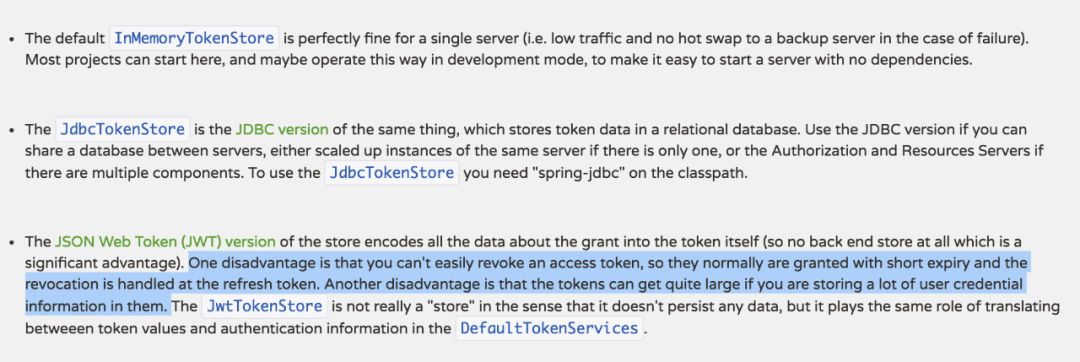
工程结构
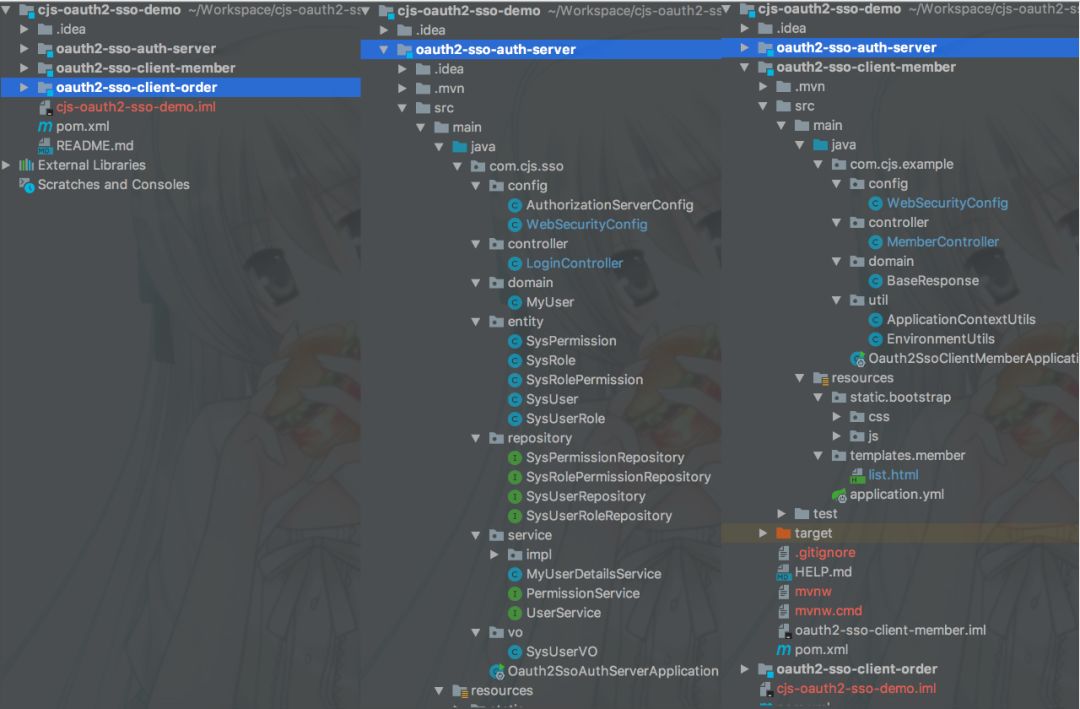
https://github.com/chengjiansheng/cjs-oauth2-sso-demo.git
演示
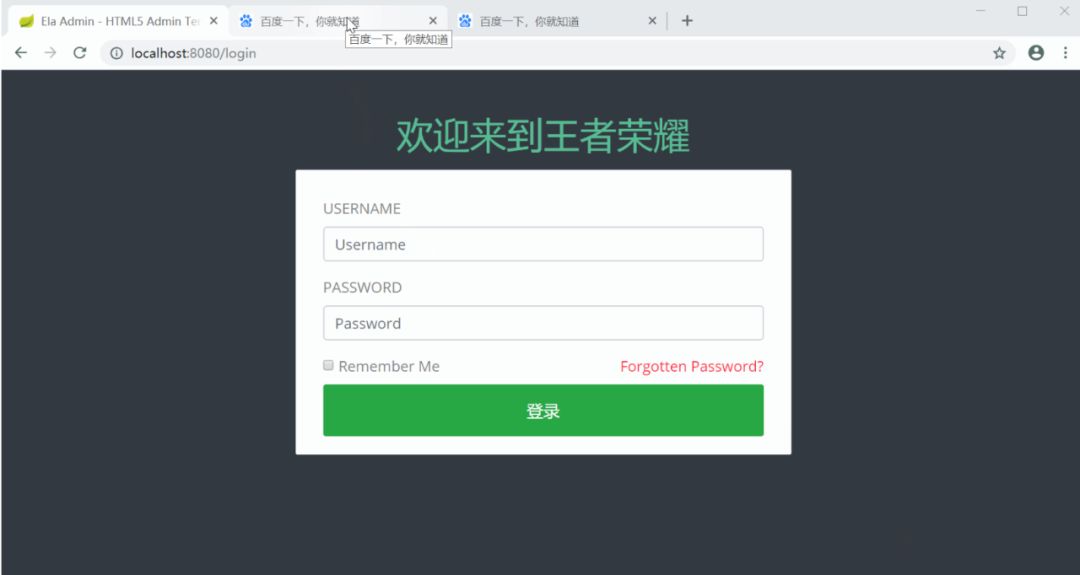
作者:废物大师兄
出处:cnblogs.com/cjsblog/p/10548022.html
推荐阅读:
